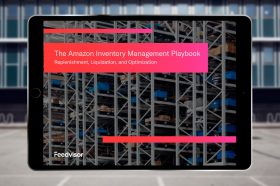Resources - Blog
Amazon Global Selling: How to Break Into International Markets

Stay on top of the latest e-commerce and marketplace trends.
After months of speculation, Amazon this week launched its retail operations in Israel with a dedicated website, enabling the nation’s local retailers to sell directly to Israeli customers using its online platform.
While Amazon first began operating in Israel in 2015 with the acquisition of Annapurna Labs, the new platform — which is currently in the English language with plans to also establish in the Hebrew language — signals the retail giant’s growing efforts to harness the Israeli e-commerce segment.
Adoption of online shopping has been slower in the Israeli market, and Israeli companies generally lag behind U.S. and European retailers in terms of quality of service and data-backed personalization efforts. Amazon’s emergence into this novice market not only fulfills the customer demand for an improved online shopping experience but also presents an opportunity for local Israeli retailers and seasoned Amazon merchants to tap into new profit potential.
In the Israeli market and beyond, sellers and brands have an opportunity to reach and build loyalty with a new audience to further expand and scale their online businesses by leveraging Amazon’s renowned logistics operation and customer-centric reputation. Below we have outlined the benefits of expanding to Amazon’s international markets as well as digestible steps you can take to get started and grow profitably.
Local Delivery is one aspect of Global Selling that looks to improve the opportunities for sellers in Israel to sell more effectively to customers in Israel who shop on Amazon.com.
What Is Amazon’s Global Selling Program?
Amazon’s booming U.S. marketplace, on pace to surpass sales of $229 billion in 2019, offers an enticing platform for online businesses to reach vast and lucrative audiences, but it is no secret that the marketplace is becoming increasingly saturated and challenging for many sellers to sustain.
To enable sellers and brands to combat competition by diversifying their selling strategies and expanding across borders, Amazon offers its Global Selling program, touting the ability for sellers to leverage Amazon’s trusted brand, reach millions of new customers, and counteract low U.S. sales periods by taking advantage of peak selling seasons in other countries.
The e-commerce giant currently operates 14 marketplaces worldwide, reaching more than 180 countries and offering products across over 30 categories, all powered by the company’s more than 175 fulfillment centers.
While opportunity is certainly ample, expanding your business abroad is not as straightforward as simply deciding where to sell. There are challenges to keep in mind, such as product regulations and demand, language barriers, and additional costs like customs, taxes, and international shipping.
Crafting Your Marketplace Entry Strategy
To first determine the international market you want to expand to, consider any sales you might already have from foreign countries. These sales suggest your existing prices and shipping model are attractive enough to convert consumers from other countries.
However, this does not mean you should immediately list all of your current best-selling inventory on the new marketplace. First, consider why your products do well in your current marketplace and alternatively consider whether those same reasons will hold true in the marketplace you are entering. How will aspects such as culture, climate, and demographics of the new marketplace impact your demand?
To better understand the consumer demands within your target marketplace as well as your competition’s strengths and weaknesses, you should review the Best Sellers, New Arrivals, and Featured Brand selections for your product categories — as well as read customer reviews and compare your products and prices with other Amazon sellers — to determine the appropriate products and price points for your new marketplace catalog.
Once you have determined where you wish to expand and which items make sense for that market, you can piggyback on your existing ASINs in that market. This allows you to initiate sales in a new market quickly and cheaply, avoiding translation costs, minimizing risks, and benefiting from preexisting product rankings.
Marketing in Other Languages
To ensure a successful launch in a new international marketplace, you must consider the local culture and social context to inform your marketing strategy and product packaging. Brand messaging and, of course, language uses that resonate in your existing market likely will not have the same resonation with your new audience.
Ideally, it should not be clear that your product packaging and brand messaging have been translated from the original language. A poor translation runs the risk of miscommunicating details, damaging your brand reputation, and hindering product discovery due to the lack of localized terminology and appropriate search terms.
Here are a few tips to keep in mind when translating your marketing to other languages:
- Only use professional translators, not just “someone who knows the language,” as this could lead to lower efficiency and quality.
- Beware of machine translations, as these typically do not account for the specificity of most sellers’ items.
- Always proofread, particularly keeping in mind transitions and flow.
Amazon also provides several services and tools to help sellers overcome the challenges around language barriers, including:
- Seller Central Language Switcher: This allows you to manage your operations in foreign marketplaces in English, providing you with a familiar interface you can quickly learn to use.
- Amazon European Marketplaces account: This enables you to create and manage product offers in all of Amazon’s marketplaces within the U.K., France, Germany, Italy, and Spain. You are in control of where you sell and you can manage your business from a single seller account interface.
- Build International Listings: When you create a connection between your home marketplace and your target marketplaces, this feature will instantly create listings in the target marketplaces based on the products you are selling in your home marketplace. It will also automatically reflect price changes from your home marketplace to your target marketplace.
Determining Your Fulfillment Method
When customers outside of your home marketplace purchase your products on Amazon, you might consider shipping them yourself internationally. However, there are several factors and costs you must keep in mind.
For instance, if your inventory is located in a different country than the marketplace in which the order was placed, you can choose a carrier that can ship internationally, but be sure to factor in additional time and financial costs due to customs and duties.
On the other hand, you might consider leveraging Amazon’s FBA program in your new target marketplace. This will require importing your products to another country for storage in an Amazon fulfillment center.
FBA is available in all of Amazon’s global marketplaces and will help you decrease the shipment time to your customers, which will make your products and brand more competitive. In addition, FBA simplifies the returns process, as Amazon will handle all returns and customer support in the local language, which otherwise might pose challenging and risky to the customer’s experience if you do not speak the language of that marketplace.
Navigating Currency Conversions and Fees
Many marketplace operators will offer a service to transfer your sales back to a bank account in your home country and in your local currency. However, these services limit your control over when the transfer takes place as well as the exchange rate you receive. Rather, consider sourcing an international payments company that could help you secure a better exchange rate and offer you more control over the transfer.
Alternately, if you wish to maintain a higher level of control over your finances, you can choose to open a bank account in the country where you want to sell. However, this can be a more complex process, as you might be required to create a legal business entity in that country. Be sure to consult your legal, tax, and banking advisors for requirements in your target marketplace.
An international payments company can also help you set up native bank accounts in which you can receive sales revenues in the country where you are selling. The company can help you transfer your funds out of the marketplace to your bank account back home at a better rate with little or no fees.
Final Thoughts
There are countless factors to consider when expanding your Amazon business to international markets. While this guide provides a condensed overview and steps to get started, the process is one that will take much time and thoughtfulness before diving straight in, or otherwise risk losing money on fees, missed sales opportunities, or a decline in your seller reputation.
However, as Amazon continues to expand its presence worldwide, it has become increasingly easy and enticing for sellers to do the same. By leveraging Amazon’s global brand reputation and supply chain, you can overcome the hurdles of building your own local brand recognition and international shipping logistics, opening your business to ample opportunity within a wider customer base.
Learn what Feedvisor can do for your business.
When you partner with Feedvisor, you automatically receive access to our true, AI-driven technology and hands-on team of e-commerce experts. Contact one of our team members today to learn more about our end-to-end solution for brands and large sellers on Amazon, Walmart, and e-marketplaces.




